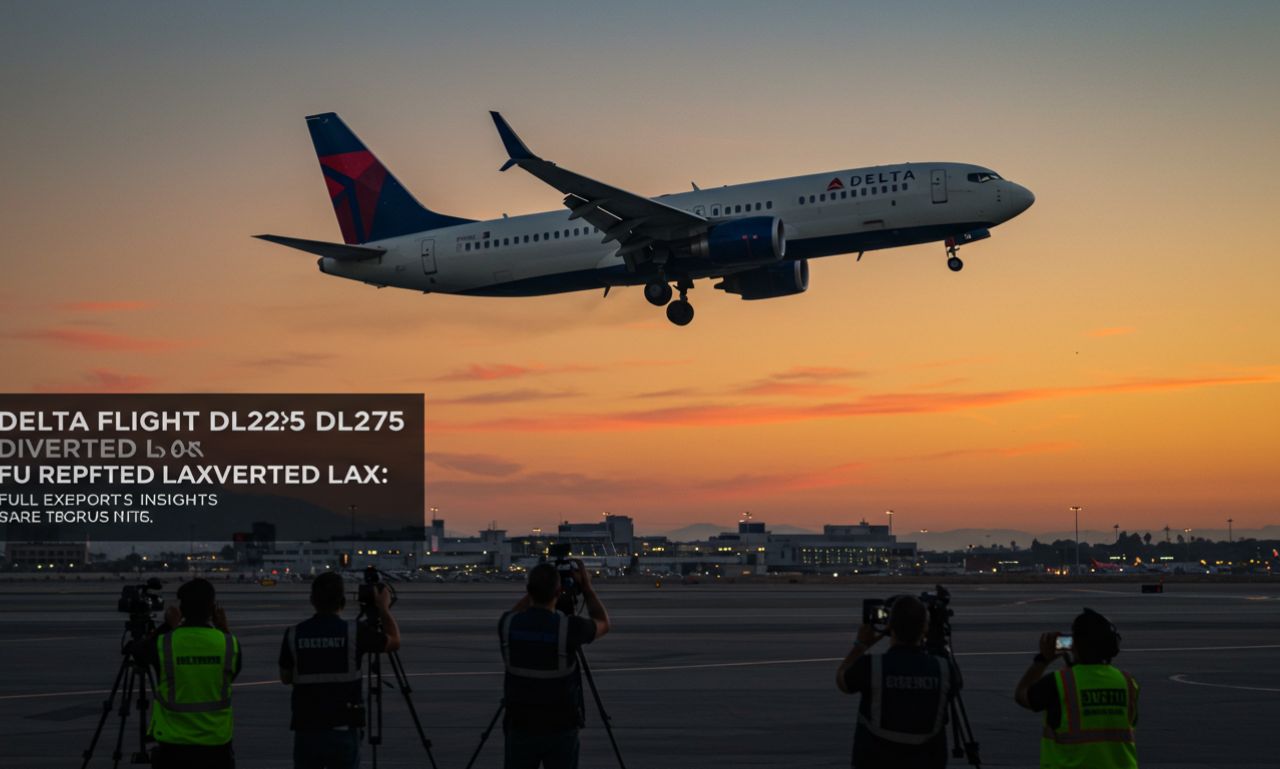On May 28, 2025, Delta Flight DL275 diverted LAX after developing a serious technical problem midair. The aircraft, an Airbus A350-900 powered by Rolls-Royce Trent XWB engines, was originally scheduled to travel from Detroit Metropolitan Wayne County Airport (DTW) to Tokyo Haneda (HND). Roughly five hours into the flight, the pilots detected an engine anti-ice system malfunction—a failure too serious to risk continuing over the Pacific Ocean.
The crew decided to divert to Los Angeles International Airport (LAX), where Delta has a major operational hub, full maintenance facilities, and specialized staff familiar with the A350. The plane eventually touched down safely at LAX in the early hours of the morning, greeted by emergency services on standby.
Though the diversion created significant disruption, the outcome was a textbook example of aviation safety working exactly as intended.
Why Did Delta Flight DL275 Divert to LAX?
Technical Malfunction in Anti-Ice System
The immediate cause of the diversion was a failure in the engine’s anti-ice system. Aircraft engines flying at high altitudes over cold, moist air are vulnerable to ice buildup, which can damage turbine blades, sensors, and airflow stability. To counteract this, engines use heated bleed air systems that prevent ice from forming.
When this protective system failed, pilots could not continue safely across remote oceanic airspace. Without anti-ice functionality, prolonged flight in icy conditions could have led to degraded performance—or even engine shutdown.
Why Not Land Closer?
Some passengers questioned why the flight continued five hours to LAX instead of landing in Anchorage or Seattle, which appeared closer on the flight map. The decision was based on aircraft maintenance support. LAX is a major hub for Delta with certified Airbus A350 mechanics, spare parts, and Rolls-Royce specialists. Anchorage, while geographically nearer, lacks the full technical infrastructure for such a complex repair.
By diverting to LAX, Delta ensured the issue could be inspected and repaired efficiently, minimizing further delays for the aircraft’s next flights.
How the Diversion Unfolded
Timeline of Events
-
Departure: Delta DL275 departed Detroit on time, heading west across North America and out over the Pacific.
-
In-Flight Issue: Around five hours into the journey, over the northern Pacific, the cockpit crew detected the anti-ice malfunction.
-
Decision Point: After evaluating risks, they elected to turn the aircraft back toward Los Angeles.
-
Diversion Route: The aircraft flew approximately five more hours south and east, maintaining safe altitude and speed.
-
Landing: The A350 landed safely on Runway 06R at LAX in the early morning, escorted by fire and rescue crews.
Passengers described the landing as smooth, with relief and applause breaking out once the plane touched down.
Passenger Experience Onboard DL275
Crew Communication
Cabin crew promptly informed passengers that a technical issue required a diversion. While some travelers expressed nervousness, most praised the professionalism of flight attendants who maintained calm, answered questions, and provided reassurance.
Passenger Emotions
Hours of extended flying understandably tested patience, but safety was always the priority. Many travelers later expressed gratitude that the pilots acted decisively rather than risking an unsafe continuation over open ocean.
After Landing
Upon arrival in Los Angeles, Delta staff organized rebookings, overnight accommodations, and meal vouchers. Some passengers continued to Tokyo on later flights, while others adjusted their plans to fit the disruption.
Operational and Financial Impact
Disruption to Delta Operations
A diversion of this scale ripples across the airline’s network. The grounded A350 required maintenance checks, meaning delays for scheduled flights. Passenger rebookings stretched staff resources at LAX, and additional crews were needed for rescheduled departures.
Estimated Financial Cost
Industry analysts estimated the total financial impact at around $2–2.5 million, factoring in:
-
Extra fuel burned during the extended diversion
-
Landing and handling fees at LAX
-
Overnight accommodations and passenger compensation
-
Maintenance and engineering inspections
-
Lost utilization of the aircraft
While costly, these expenses pale in comparison to the risks avoided by not pressing onward.
Delta Flight DL275 Diverted LAX: Technical Insights
About the Airbus A350-900
The Airbus A350 is one of the most advanced long-haul aircraft in operation. Equipped with Rolls-Royce Trent XWB engines, it is renowned for efficiency, reliability, and long-range capability.
How the Anti-Ice System Works
The anti-ice system channels hot compressed air from the engine’s compressor section to heat surfaces vulnerable to freezing. If this system fails, ice could accumulate on fan blades or sensors, potentially leading to engine instability.
Built-In Safety Redundancies
Although one system malfunctioned, the aircraft remained fully airworthy thanks to multiple redundancies. The diversion was not a sign of imminent danger but a preventive measure—choosing safety over risk.
Lessons Learned from the Diversion
Importance of Hubs
The decision to head for LAX illustrates why airlines invest heavily in strategic hubs. Having specialized crews, spare parts, and engineering expertise on hand can make the difference between a lengthy grounding and a quick recovery.
Pilot Decision-Making
The crew’s choice reflects extensive training. Commercial pilots undergo scenario planning for exactly these moments—balancing passenger safety, technical support, and flight time considerations.
The Role of Predictive Maintenance
Experts note that advancements in AI-driven predictive maintenance could help airlines detect potential component issues before they escalate in flight. Such technologies may reduce future diversions by allowing ground fixes earlier.
Comparisons to Other Diversions
Flight diversions due to mechanical issues are rare but not unheard of. In 2024, several long-haul flights across the Pacific and Atlantic diverted for similar reasons—ranging from sensor malfunctions to minor fuel irregularities. Each incident reinforces the “safety first” culture embedded in aviation worldwide.
Industry and Passenger Reactions
Aviation Industry
Aviation experts praised Delta for transparency and safety-first decision-making. The swift coordination between crew, maintenance, and ground staff turned what could have been a crisis into a smooth resolution.
Passenger Perspectives
Most passengers expressed frustration at delays but also relief and gratitude for the crew’s professionalism. Many shared their experiences on social media, highlighting Delta’s customer support after the diversion.
Broader Implications for Air Travel
The DL275 diversion emphasizes three key lessons for global aviation:
-
Preparedness is everything – Airlines must maintain hubs with technical support ready at all times.
-
Communication matters – Keeping passengers informed reduces anxiety and builds trust.
-
Technology is evolving – Predictive analytics and real-time diagnostics will play a larger role in avoiding diversions in the future.
Conclusion
The Delta Flight DL275 diverted LAX incident is a case study in aviation safety, operational strategy, and crisis management. While the anti-ice malfunction caused long delays and costly disruption, the safe landing at LAX was proof that aviation systems—from aircraft design to crew training—work exactly as they should.
For passengers, it was an inconvenience. For Delta, it was an expensive logistical headache. But in the broader picture, the event reaffirmed why modern air travel remains one of the safest modes of transportation in the world. With advancements in predictive maintenance and AI, diversions like DL275’s may become even rarer in the years ahead.

